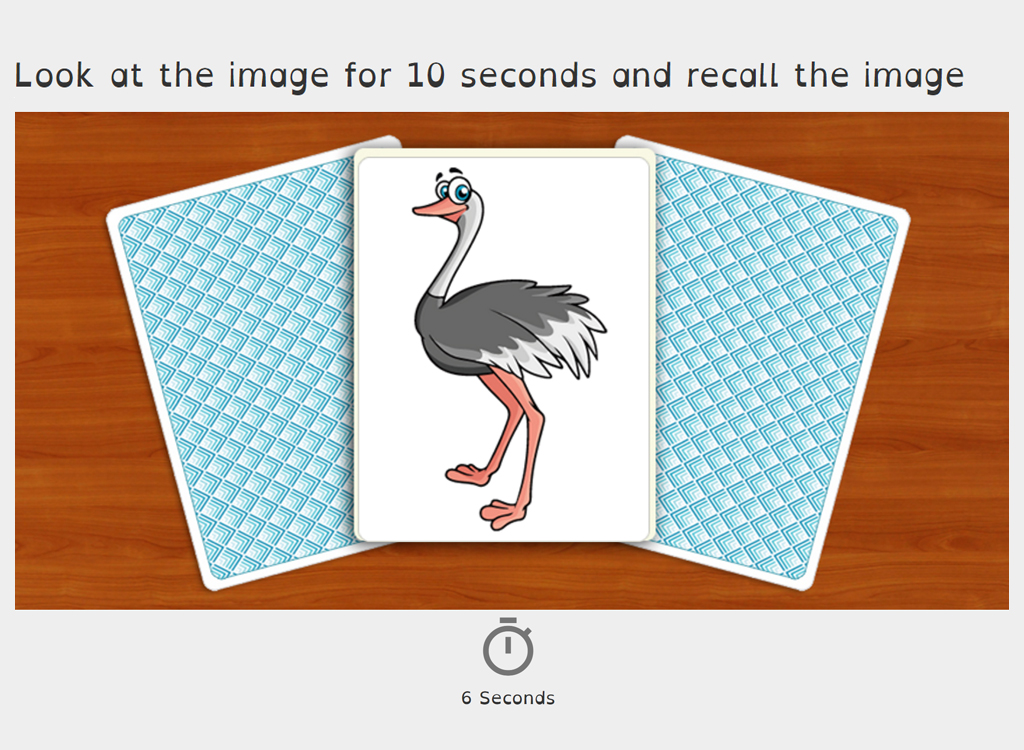Card Game
This is a game to test your child’s short term memory.
What is short term memory?
We can hold a small amount of information for some time. This is short term memory. We do not remember the telephone number which we have dialled after some time though we carefully dialled the number. We read a sentence with full concentration but we may forget the sentence after some time. So we hold information only for a short time.
Why short term memory is important?
Short term memory is important to do efficiently many things. Short term memory is required while reading because the reader must remember the last few sentences to understand the passage. When doing maths, the child has to remember the steps to solve the problem. Our brain cannot store information directly. From short term memory, the information needed to be stored is transferred to the long term memory. If our short term memory ability is not strong, then the long term memory also gets affected. Students with learning difficulty have problems with short term memory.
How can you improve the short term memory of your child?
You can train your child to improve her/his memory skills. Perhaps, the most effective method is to ask questions and force the brain to recall information. Some questions you can ask your child are: 1.What was the colour of the sari your English teacher wore today? 2. Who came to our house yesterday? 3. What did we have for breakfast today? 4. What day is today? 5. What is our PIN code number? 6. Who were absent in your class today? 7. Name two pictures in this lesson?
It is not difficult to prepare a list of questions to ask your child. Ask questions to your child every day. This will improve the observation power of the child. Also, the child starts paying attention to details.
The card game is a visual activity to improve the short term memory of your child. The child is required to recall information.
In this game, the child can see an image for 10 seconds. The image disappears and the child is shown six options. The child has to click on the right option and submit the answer. If the answer is wrong, a message would be displayed. Play again with the help of this clue to get the right answer. The correct answer would be displayed if the child fails in the second attempt.
Tips for you, the parents.
How to take this activity forward?
We strongly recommend you to buy a whiteboard and use different coloured marker pens.
In this activity we have used only one image to be recalled. You can make an advanced version of this game by writing two words or drawing two pictures or one word and one picture. You can also use shapes and numbers. Use different colours for better visual appeal.
Ask the child to study the images. Erase what you have written/ drawn after 10 seconds or so and then ask the child to recall the images.
You can use this activity for revision. Examples: 1. Spelling of words 2. To remember formula- area of a rectangle is lxb. 3. Valency of carbon 4. Dates in history lessons etc.
Repeating the activity will improve your child’s short term memory. Short term memory is very useful for copying from the board, connecting ideas while reading, following instructions and doing maths.
-
Many educational toys are available which improve the memory of children. Funskool has come out with some memory games.
Memory games can be created at home using a pack of card. A pack of cards has four sets- spades, clubs, (black) diamonds and hearts (red). Take two sets of identical cards and each set having eight cards.Example one set having numbers 1 to 8 black and another set of 1 to 8 red. Shuffle the cards and spread these face down on the floor. The game can be started by a player opening one card and this is seen by all the players. The player can open one more card and this is kept face up so that all the players can see the card. If the numbers match, the player can keep the two cards. The first player gets one more chance to play. He continues playing as long as he is able to pick the matching cards. If he cannot find a matching pair, then the player keeps the opened cards face down. The players play in turn. The player who collects the maximum number of cards is the winner.It need not always be played with 16 cards. The number of cards can vary.

